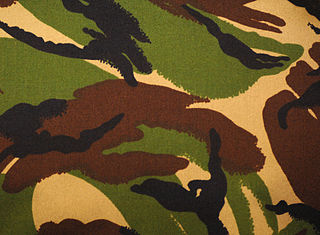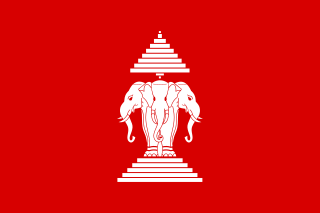
The National People's Army were the armed forces of the German Democratic Republic (GDR) from 1956 to 1990.

Flecktarn is a family of three-, four-, five- or six-color disruptive camouflage patterns, the most common being the five-color pattern, consisting of dark green, grey-green, red brown, and black over a light green or tan base depending on the manufacturer. The original German five-color pattern was designed for use in European temperate woodland terrain. A three-color variation called Tropentarn is intended for arid and desert conditions; the German Bundeswehr wore it in Afghanistan.

The Stahlhelm is a German military steel combat helmet intended to provide protection against shrapnels and fragments or shards of grenades. The term Stahlhelm refers both to a generic steel helmet and more specifically to the distinctive German military design.
The Karabinek-granatnik wzór 1960, also designated PMK-DGN-60 or PMK-60, is a Polish-made version of the AK-47 assault rifle that can fire rifle grenades.

The Felix Dzerzhinsky Guards Regiment was the paramilitary wing of the Ministry for State Security (Stasi), the security service of the German Democratic Republic (GDR).

Disruptive Pattern Material (DPM) is the commonly used name of a camouflage pattern used by the British Armed Forces as well as many other armed forces worldwide, particularly in former British colonies.

Tiger stripe is the name of a group of camouflage patterns developed for close-range use in dense jungle during jungle warfare by the South Vietnamese Armed Forces and adopted in late 1962 to early 1963 by US Special Forces during the Vietnam War. During and after the Vietnam War, the pattern was adopted by several other Asian countries. It derives its name from its resemblance to a tiger's stripes and were simply called "tigers." It features narrow stripes that look like brush-strokes of green and brown, and broader brush-strokes of black printed over a lighter shade of olive or khaki. The brush-strokes interlock rather than overlap, as in French Lizard pattern (TAP47) from which it apparently derives.
The 40. Fallschirmjägerbataillon Willi Sänger was the only airborne forces unit formation of the National People's Army, formed in 1962. The battalion was based in Prora on Rügen island (1962–82) and later near Potsdam (1982–90). Numerous military observers had considered the unit to be one of the most professional forces in the Warsaw Pact despite its small size.

The Kamuflirovannyy Letniy Maskirovochnyy Kombinezon or KLMK is a military uniform with a camouflage pattern developed in 1968 by the Soviet Union to overcome the widespread use of night vision optics and devices by NATO countries. This one-piece camouflage suit became one of the most widely used in the Soviet Union.

The helmet cover was first used by French soldiers during World War I.

The Universal Camouflage Pattern (UCP) is a digital military camouflage pattern formerly used by the United States Army in their Army Combat Uniform. Technicians at Natick Soldier Systems Center attempted to devise a uniform pattern that would mask the wearer in all seasonal environments. Laboratory and field tests from 2003 to 2004 showed a pattern named "All-Over-Brush" to provide the best concealment of the patterns tested. All-Over-Brush was selected as the winner over ten other patterns. The disadvantage of an all-in-one pattern is that it is a combination of what is effective in many different environments and is less effective in a particular environment when compared to a specialized coloration designed specifically for that environment. The winning All-Over-Brush pattern was not used as the final UCP. Instead, U.S. Army leadership utilized pixellated images taken from Canadian CADPAT and US Marine Corps MARPAT, then recolored them based on three universal colors developed in the Army's 2002-2004 tests, to be called the UCP. While the pixelated pattern of the UCP is similar to the MARPAT and CADPAT camouflage patterns used by the United States Marine Corps and the Canadian Armed Forces, its coloration differs significantly. The final UCP was then adopted without field testing against other patterns.

The lizard pattern is a family of many related designs of military camouflage pattern, first used by the French Army on uniforms from 1947 to the late 1980s. It was based on the British paratroopers' Denison smock. The use of the pattern is widespread in Africa, despite its association with France, because armed factions and militaries tend to obtain them from whichever source has it available.

The U.S. Woodland is a camouflage pattern that was used as the default camouflage pattern issued to the United States Armed Forces from 1981, with the issue of the Battle Dress Uniform, until its replacement in the mid to late 2000s. It is a four color, high contrast disruptive pattern with irregular markings in green, brown, sand and black. It is also known unofficially by its colloquial moniker of "M81" after the Battle Dress Uniform it was first used on, though this term was not officially used by the U.S. military.

The ERDL pattern, also known as the Leaf pattern, is a camouflage pattern developed by the United States Army at its Engineer Research & Development Laboratories (ERDL) in 1948. It was not used until the Vietnam War, when it was issued to elite reconnaissance and special operations units beginning early 1967.

The Royal Lao Army, also designated by its anglicized title RLA, was the Land Component of the Royal Lao Armed Forces (FAR), the official military of the Kingdom of Laos during the North Vietnamese invasion of Laos and the Laotian Civil War between 1960 and 1975.

Splittertarnmuster, Splittertarn or Splittermuster (splinter-pattern) is a four-colour military camouflage pattern developed by Germany in the late 1920s, first issued to the Reichswehr in 1931.

The Camouflage Central-Europe is the standard camouflage pattern of the French Armed Forces.

Jigsaw camouflage is the colloquial term for a series of camouflage patterns used by the Belgian Armed Forces between 1956 and 2022 and subsequently adapted in several other countries.

The Frog Skin, also known as Duck Hunter, is a battledress camouflage pattern with mottle and disruptive coloration to blend into the environment similar to a frog's crypsis skin.

Camouflage Daguet is the French military's current desert camouflage. It is the desert variant of Camouflage Central-Europe.



















